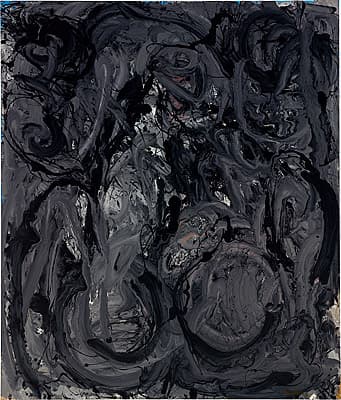
Michael
TAYLOR
Australia
1933
Europe 1960-63;
United States of America, India, Europe 1974-75
Caryatid
1963
oil on enamel on canvas
signed and dated l.r., in orange oil paint, "Taylor/63";
titled reverse stretcher u.l., fibre tipped pen, "CARYATID";
signed reverse support, u.l., in fibre tipped pen, "M. TAYLOR".
198.2 (h)
x 170.8 (w)
cm
Purchased 1972
National Gallery of Australia, Canberra
NGA 1972.356
© Michael Taylor
- with Macquarie Galleries, Canberra;
- from whom bought by the Acquisitions Committee of the Australian National Gallery, September 1972
- Abstract Expressionism: the National Gallery of Australia celebrates the centenaries of Jackson Pollock and Morris Louis
- 14 Jul 2012 – 24 Feb 2013
- Daniel Thomas, Michael Taylor paintings 1961–72, Canberra: Macquarie Galleries 1972;
- Deborah Clark, The Antipodeans: Challenge and response in Australian art 1955–1965, Canberra: National Gallery of Australia 1999, p. 33, illus col., p. 47
Michael Taylor is one of Australia’s foremost Abstract Expressionist artists. In work after work since the early 1960s, he has meshed feelings for the world around him with dynamic gestural expression. Yet the adventurous, bold, expressive qualities in Caryatid 1963 were hard-won.
Although Taylor’s art training was largely traditional, he notes that adventurous teachers like Ralph Balson and Godfrey Miller also ‘got a look in’.[1] He attended numerous classes with Balson, one of the most gifted abstract artists working in Sydney at the time.[2] Taylor recalls that it was very hard to see good reproductions of abstract art, let alone actual works. ‘We used to go to Carl Plate’s bookshop in Rowe Street. They were mainly little books on abstract art and they were few and far between.’ Apart from artists like Balson, a new way forward was suggested in the 1950s with the exhibition Direction 1, which Taylor recalls, caused ‘quite a stir’.[3] The work of Australian artists such as John Olsen, Robert Klippel and William Rose suggested a new freedom of expression, directions which came not from the Americans but from European artists of the School of Paris like Alfred Manessier, Vieira Da Silva and Jean-Paul Riopelle.
Taylor also absorbed influences from further afield. As part of his New South Wales Travelling Scholarship, awarded in 1960, he stayed for a time in England and then spent most of his three years away in Europe. He recalls seeing his first works by Willem de Kooning in London, as well as some early Jackson Pollock paintings in travelling exhibitions at this time. Later, canvases such as Caryatid were seen to reflect aspects of Taylor’s interest in Spanish art and culture. As Daniel Thomas observes:
During his European studies Spain was where he was most at home. Spain is the country of black painting, of fiercely aristocratic, impersonal passion, the country of Velasquez and Goya and, in our time, of Tapies …
The best black paintings aren’t dead black, they give their darkness a velvety glow, lights shine like silver, tender touches of pink hint of sensuous flesh …
Underneath the extreme, dignified reserve of black, there may lurk a passionate sensualist.[4]
Caryatid is not purely abstract. As the title implies, and a related drawing in the Gallery’s collection suggests, the painting is symbolic of the female form.[5] It connects with the ancient idea that Taylor expressed as the ‘female figure carrying the burdens of the world’. Symbolic resonances are combined with an intensity of feeling and a sensuous, rich painterly surface. As Deborah Clark writes, the painting is ‘an expression of restless energy and force. The furling and unfurling tendrils of paint across the surface are part of a complex layering of dark and light tones, which give the work great depth.’[6] In later years, following his move to rural Cooma, Taylor’s approach began to relate to the natural environment, often incorporating more vivid colour while retaining the intensity and vitality that informed his seminal works of the early 1960s.
Deborah Hart
[1] Michael Taylor notes that it was more traditional, figurative artists like Herbert Badham who dominated the classes, whereas Balson and Miller were sidelined. Michael Taylor in discussion with Deborah Hart, by telephone, August 2012; the artist’s comments are from this interview, unless credited otherwise.
[2] Taylor recalls: ‘We were all painting abstract geometric works in Balson’s classes with flat brushes and I recall him coming up to me one day and suggesting that I might use a rounded brush instead. It suggested another direction.’
[3] Direction 1 opened at Macquarie Galleries, Sydney, in December 1956.
[4] Daniel Thomas, Michael Taylor paintings 1961–72, Canberra: Macquarie Galleries 1972, n.p.
[5] Sitting woman, study for Caryatid 1963, ink on paper, 18 x 12.5 cm (sheet), NGA 1973.212
[6] Deborah Clark, The Antipodeans: Challenge and response in Australian art 1955–1965, Canberra: National Gallery of Australia 1999, p. 33
The National Gallery of Australia holds a total of 115 works by Michael Taylor, 65 drawings, 19 paintings, and 31 drawings.
